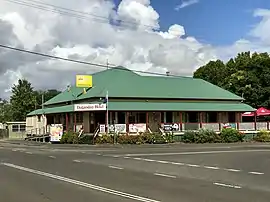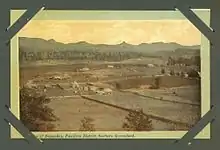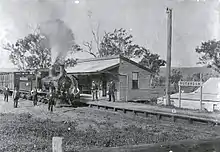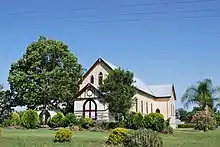Dugandan, Queensland
Dugandan (pronounced Doog-an-dan) is a rural town and locality in the Scenic Rim Region, Queensland, Australia.[2][3] In the 2016 census, Dugandan had a population of 593 people.[1]
| Dugandan Boonah, Queensland | |||||||||||||||
|---|---|---|---|---|---|---|---|---|---|---|---|---|---|---|---|
 Dugandan Hotel, 2018 | |||||||||||||||
 Dugandan | |||||||||||||||
| Coordinates | 28.01°S 152.6813°E | ||||||||||||||
| Population | 593 (2016 census)[1] | ||||||||||||||
| • Density | 40.90/km2 (105.9/sq mi) | ||||||||||||||
| Postcode(s) | 4310 | ||||||||||||||
| Area | 14.5 km2 (5.6 sq mi) | ||||||||||||||
| Time zone | AEST (UTC+10:00) | ||||||||||||||
| Location |
| ||||||||||||||
| LGA(s) | Scenic Rim Region | ||||||||||||||
| State electorate(s) | Scenic Rim | ||||||||||||||
| Federal Division(s) | Wright | ||||||||||||||
| |||||||||||||||
History

The name Dugandan is believed to be an Aboriginal word dugai/tugai meaning mountain spur place.[2][3] Originally the name was used for a large pastoral run established in 1884, covering a much larger area than the current locality from Boonah to Mount Joyce. As a result, the name Dugandan was used for the present day town of Boonah until the 1880s when it acquired its present name.[4]
In January 1861, a native police detachment led by Lieutenant Frederick Walker was dispatched to Dugandan Scrub, to the south of the present town, to "disperse" the local aboriginals who were camped in the area. This was in response to a request from the settler John Hardie. When the native police ambushed their camp during the night, at least two were killed,[5] with possibly as many as 40 being killed.[6]
The Dugandan Provisional School which opened in 1878 was located in (present day) Boonah. This school was renamed Boonah State School in 1895.[7]

In 1886 Carl Stumer erected the Dugandan General Store. It was raised following flooding in 1887. In 1913 it was renovated and became the Dugandan Hotel. There was an earlier hotel in Boonah called the Dugandan Hotel but it was not operating in 1913.[8]
The Fassifern railway line (Queensland's first branch railway line) was extended from Harrisville to Dugandah and opened on 12 September 1887 with the town being served by Dugandan railway station (27.9969°S 152.6816°E). (The line originally opened from Ipswich to Harrisville on 10 July 1882.) The line closed in June 1964.[9][10]
By 1887 a sawmill was already established in Dugandan under the combined partnership of Josias Hancock and James Cossart.[11] The mill burned down in 1897.[12] Cossart's Mill became one of the major employers in the region and contributed significantly to the prosperity of Boonah and Dugandan into the twentieth century. It was located at (28.0056°S 152.6753°E) to the south of the Dugandan railway station.[13]
Dugandan Post Office opened on 11 September 1887 (a receiving office had been open from 1881) and closed in 1929.[14]
In 1882 the Primitive Methodist Church congregation had grown too large to continue to use the Provisional School.[15] Thomas Hardcastle donated 1 acre (0.40 ha) of land for a church on Old Mount Alford Road near the former Dugandan Bridge.[16] There was a ceremonial cutting of the first sod on Saturday 23 December 1882 by Miss Jessie Hardcastle.[17][18] The church was 22 by 14 feet (6.7 by 4.3 m) and built by George Beverley and T. Austin. It was officially opened on 4 November 1883.[19] In 1892 concerns about flooding led to fundraising to relocate the church to the southern end of High Street in Boonah (now the location of the manse).[20][21][22]

The Trinity Lutheran church opened on 23 April 1889.[23][24]
Dugandan State School opened in Dugandan on 13 January 1917 (and is not related to the school which opened in 1878). It closed in 1966.[7]
In the 2016 census, Dugandan had a population of 593 people.[1]
Demographics
Dugandan has a population of 593 at the 2016 census. The locality contains 254 households, in which 47.7% of the population are males and 52.3% of the population are females with a median age of 45, 7 years above the national average. The average weekly household income is $1,125, $313 below the national average.
3.1% of Tarome's population is either of Aborigional or Torres Strait Islander descent. 63.4% of the population aged 15 or over is either registered or de facto married, while 36.6% of the population is not married. 29.2% of the population is currently attending some form of a compulsory education. The most common nominated ancestries were Australian (31.5%), English (29.8%) and German (13.4%), while the most common country of birth was Australia (83.0%), and the most commonly spoken language at home was English (93.8%). The most common nominated religions were Catholic (23.9%), Anglican (18.3%) and No religion (18.2%). The most common occupation was a labourer (20.1%) and the majority/plurality of residents worked 40 or more hours per week (40.9%).[1]
Heritage listings

Dugandan has the following heritage sites:
- 124 Boonah-Rathdowney Road (28.0045°S 152.6808°E): Dugandan Hotel [8]
- 237 Boonah-Rathdowney Road (28.01355°S 152.67569°E): Trinity Lutheran Church and Cemetery[24]
References
- Australian Bureau of Statistics (27 June 2017). "Dugandan (SSC)". 2016 Census QuickStats. Retrieved 20 October 2018.

- "Dugandan – town in Scenic Rim Region (entry 10750)". Queensland Place Names. Queensland Government. Retrieved 19 September 2020.
- "Dugandan – locality in Scenic Rim Region (entry 45136)". Queensland Place Names. Queensland Government. Retrieved 19 September 2020.
- "Boonah". Queensland Places. Centre for the Government of Queensland, University of Queensland. Archived from the original on 27 April 2014. Retrieved 28 April 2014.
- "The Native Police". The Maitland Mercury and Hunter River General Advertiser. XVIII (1974). Maitland. 12 January 1861. p. 7. Retrieved 17 January 2021 – via National Library of Australia.
- "Hardie's Station massacre". c21ch.newcastle.edu.au. Centre for 21st Century Humanities, University of Newcastle. Retrieved 17 January 2021.
- "Agency ID 8793, Dugandan State School". Queensland State Archives. Retrieved 28 April 2014.
- Local Heritage Register, pp 64-66
- Kerr, John (1990). Triumph of narrow gauge : a history of Queensland Railways. Boolarong Publications. pp. 57–58, 224. ISBN 978-0-86439-102-5.
- "Towns of Boonah and Dugandan" (Map). Queensland Government. 1981. Archived from the original on 30 May 2020. Retrieved 30 May 2020.
- "Advertising". Queensland Times, Ipswich Herald And General Advertiser. XXVIII (3960). Queensland, Australia. 29 October 1887. p. 5. Retrieved 3 October 2016 – via National Library of Australia.
- "Destructive Fire at Dugandan". Queensland Times, Ipswich Herald And General Advertiser. XXXVII (5600). Queensland, Australia. 1 June 1897. p. 5. Archived from the original on 22 December 2020. Retrieved 3 October 2016 – via National Library of Australia.
- Kerr, John (January 1998). "Report on site visits" (PDF). Queensland Government (published 1998). p. 206. Archived from the original (PDF) on 30 May 2020. Retrieved 30 May 2020.
- Premier Postal History. "Post Office List". Premier Postal Auctions. Archived from the original on 15 May 2014. Retrieved 10 May 2014.
- "Advertising". Queensland Times, Ipswich Herald And General Advertiser. XXII (3148). Queensland, Australia. 26 September 1882. p. 2. Retrieved 3 October 2020 – via National Library of Australia.
- "PRIMITIVE METHODIST CHURCH, DUGANDAN". Queensland Times, Ipswich Herald And General Advertiser. XXII (3187). Queensland, Australia. 28 December 1882. p. 3. Archived from the original on 22 December 2020. Retrieved 3 October 2020 – via National Library of Australia.
- "LOCAL AND GENERAL NEWS". Queensland Times, Ipswich Herald And General Advertiser. XXII (3186). Queensland, Australia. 23 December 1882. p. 3. Archived from the original on 22 December 2020. Retrieved 3 October 2020 – via National Library of Australia.
- "IPSWICH". The Brisbane Courier. XXXVII (7, 789). Queensland, Australia. 29 December 1882. p. 5. Archived from the original on 22 December 2020. Retrieved 3 October 2020 – via National Library of Australia.
- "LOCAL AND GENERAL NEWS". Queensland Times, Ipswich Herald And General Advertiser. XXIII (3324). Queensland, Australia. 13 November 1883. p. 3. Archived from the original on 22 December 2020. Retrieved 3 October 2020 – via National Library of Australia.
- "Country Correspondence". Queensland Times, Ipswich Herald And General Advertiser. XXXIII (4814). Queensland, Australia. 7 May 1892. p. 6. Retrieved 3 October 2020 – via National Library of Australia.
- "Australian Christian Church Histories - Boonah, QLD - Methodist". Australian Christian Church Histories. Archived from the original on 2 October 2020. Retrieved 2 October 2020.
- "The Beginning of Methodism in Boonah". Fassifern Uniting Church. Archived from the original on 2 October 2020. Retrieved 2 October 2020.
- "LUTHERAN CHURCH". Queensland Times (Ipswich) (Qld. : 1909 - 1954). Ipswich) (Qld.: National Library of Australia. 17 April 1939. p. 6 Edition: DAILY. Retrieved 28 April 2014.
- Local Heritage Register, pp 67-69
Sources
- "Local Heritage Register" (PDF). Scenic Rim Regional Council. Archived from the original (PDF) on 24 September 2015. Retrieved 9 February 2015.
External links
- "Dugandan". Queensland Places. Centre for the Government of Queensland, University of Queensland.
- "Town map of Dugandan". Queensland Government. 1981.
- Dugandan Lutheran Cemetery